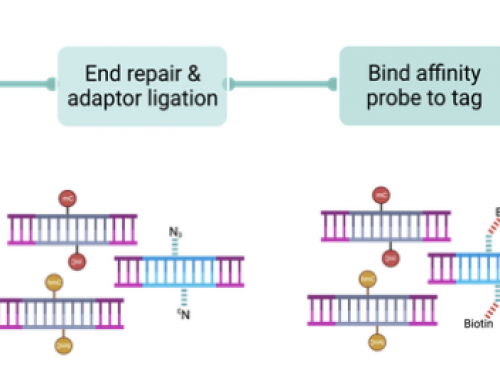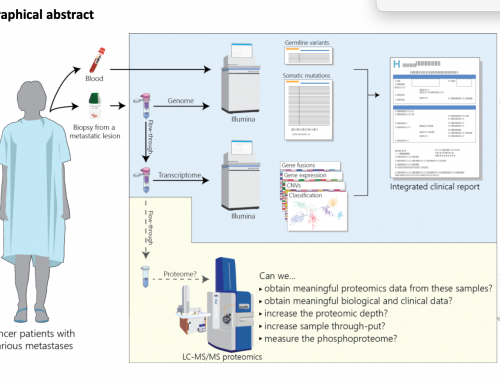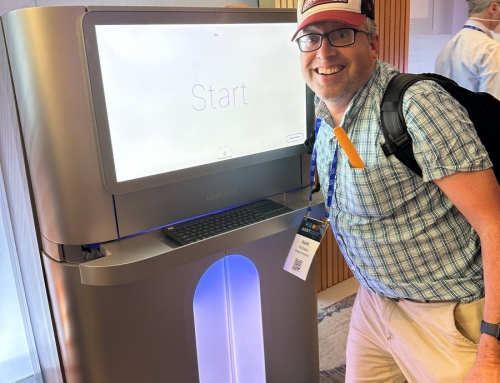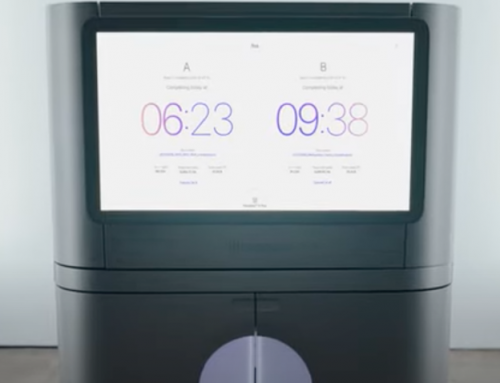HiSeq X Ten: Illumina are making big news that this instrument(s) will finally deliver the holy grail of the $1,000 genome. Initial customers include Macrogen, the Broad Institute, and the Garvan Institute of Medical Research. Illumina says the $1000 genome is “inclusive of typical instrument depreciation, DNA extraction, library preparation, and estimated laborâ€, we’ll have to see if the sums make sense. They talk about “it†when referring to X Ten but this really means them, 10 instruments makes one X Ten. Improvements have been made to optics and chemistry so that HiSeq X Ten runs faster than previous instruments, 10x quicker than the current HiSeq 2500 (although it is not clear if this means HiSeq 2500 can’t go faster or just needs to wait for the 1TB upgrades). HiSeq X Ten also uses new patterned flowcells which use nanowells (I covered an Illumina patterned flowcell patent last year) and new clustering chemistry to generate 6 billion clusters per run, compare that to MiSeqs 25M or HiSeq 2500 high-output’s 3.2B.
NextSeq 500: “the HiSeq in a MiSeq†brings the performance of HiSeq 2500 into a desktop instrument priced at $250,000. Again there are advances in optics, fluidics and chemistry to enable this. Users can choose between two output modes: 130M or 400M clusters per run which would generate 120Gb in a PE150bp configuration, or four 30x WGS at a reagent cost of what looks like $4000 according to GenomeWeb coverage. New optics allow six cameras in a single unit one third of the cost of the current model,and now use an LED allowing Illumina to “significantly reduce the size, weight, and cost of the optics”. New SBS chemistry uses just two detection channels and “sequencing with half the images” according to Jay Flatley. Other innovations are the new flowcells with larger clusters that are shipped and stored dry, integrated fluidics and new chemistry which is stable for a full run at room temp eliminating the need for a chiller. As the optics and fluidics have been major costs of the Illumina systems these improvements should make the instruments cheaper to manufacture, and more robust saving field service/engineer visits, something I’m sure many users will be happy to see.
I’m going to digest the announcements and plan a few posts over the next couple of weeks about the new flowcells, the new chemistry and what this might mean for HISeq 2500. My feeling is good news for those who can upgrade to 1TB, depending on the cost, but bad news for those who’s instruments are too old.










You mention 6B clusters for HiSeq Ten but website http://www.illumina.com/systems/sequencing.ilmn shows 3B reads per flow cell († clusters passing filter). Can you square the circle ? Thanks.
I think the confusion comes from whether you count a flowcell or a run (a pair of flowcells). Each flowcell generates 3B reads so 2 would get to the 6B Illumina quote in the press release.
I don't get it…..you have buy ten identical instruments. They are capable of performing individually and don't work in parallel on the same samples in real time so what's the point of selling in tens only? That’s $10,000,000, it’s not like buying a packet of frankfurts!
So how many institutes are capable of 18,000 genomes per year? What about downtime and maintenance costs. And of those that are what about the bioinformatics burden, annotation and comparative, which doesn’t appear included in the claimed $999.
Anyway, why is that much data impressive? Because it’s a big number? I mean there's that much data because the reads are still too short. Sure they've made things faster but not improved the quality and usability of the data and done little to address the elephant in the room being the bioinformatics workflow.
So Illumina are now alienating the majority of its customer base from the use of their new technology for no real reason. Sure the old instruments are now reduced but so what, who wants to buy old technology. Seems to me the reason is to claim the $1000 dollar genome title but $1000 is still way too expensive and the truth is the technology which has been remarkable is at the limits of its performance and HiSeq X Ten only proves that. I find the whole thing smacks of desperation.
Apologies, have only just seen reply so thanks for this. By the way are these the so called "patterned" flow cells or are those still to come ?